STILLWATER AND RESERVOIR FLY FISHING GUIDE: KIELDER WATER

No longer dismissed as a giant stock pond, the Northumbrian reservoir celebrates its 21st ann iversary this year by providing trout anglers with his best-ever sport. An drew Wilkinson is your guide to the 2,700-acre water
GIANT KIELDER Water, Britain’s second largest man-made reservoir, is the North’s equivalent of Rutland. Yet for years, many North-East anglers preferred to drive south down the A.1 to the Leicestershire fishery rather than fish their local water.
Now that is all reversed as stocking at Kielder has dramatically increased, and many southern-based competition anglers are happy to drive north to test their skills against the local anglers and the “canny” fish of Kielder.
Hidden away in the vast Kielder Forest on the Northumbrian/Scottish border, the 2,700-acre reservoir was built to provide water for the industry of Teesside. With a shore line stretching for 27 miles, the reservoir will never be crowded until sheep learn to fish. For there are five times as many sheep as people in Northumberland.
It would be nigh on impossible to stock the venue to the density of some reservoirs, but Northumbrian Water do pile in the fish. and even when the rainbows are elusive, the wild brownies can be most obliging.
There are bays in Kielder bigger than the average reservoir, and even when fishing in one of the matches when all the boats are out, there will be fellow competitors you won’t see – even with binoculars – until you are back in the spacious Leaplish bar enjoying a pint.
But while awesome is an apt adjective for this giant, the reservoir can be kind and gentle too. There are days when the sun beats down, and a gentle drift down an area such as Plashetts can bring fish after fish on Buzzers in the surface film.
I remember such a day fishing with local expert Don Coe, who put us right on the rising fish. Several drifts parallel to the bank brought a spell of super sport.
In fact most of the fish tend to hug the banks so, despite its size, you can virtually discount huge areas of water, and fish close to the banks. Over the course of a season the rod average from bank and boat will be pretty similar.
Part of Kielder’s appeal is its remoteness. Surrounded by pine forests and hidden away in a vast wilderness, the atmosphere and wildlife here is quite different to what you will encounter anywhere else south of the Scottish border.
There’s a good chance of spotting a red squirrel, while badgers, and roe deer favour the area. There around 6,000 roe deer in the Kielder Forest, which covers around 230 square miles. As for bird life, sparrowhawks find the woods the perfect hunting ground, while crossbills and the occasional osprey are among the rarer species.
The trees are mainly sitka and Norway spruce, though more broadleaf species are being introduced.
For a managed area it retains a wild and beautiful feel, and the joy of seeing the water stretch before you as you drive to the brow of the hill by the dam, never diminishes.
Kielder is younger than most of those who fish it, as it is currently celebrating its 21st year. To mark the occasion 21,000 fish are being stocked this year, around 6,000 more than usual.
Stocking takes place weekly from different points, the fish tending to follow the prevailing wind, thereby making their way towards the dam, though there’s no need for anglers to flock there, as the fish can take days to arrive, by which time further stocking will have taken place.
TACTICS
ONLY in times of flat calm – which are rare – will fish venture far away from the bank, so boat anglers are advised to drift parallel to the bank, or into it from around 50 yards out.
Bank anglers regularly catch when punching lines out into the wind, and easing them back into the breakers that lash against the shore.
“Focus on the small area you are fishing, and forget about the vastness,” advises Peter Pattinson, of Northumbrian Water, who has fished Kielder for 12 years since he was 14 and has caught rainbows to 6lb.
“It’s not a big fish water, though we do put in a few doubles,” he said. “But it’s so big that we have to concentrate on numbers, rather than size. We stock with hen fish and triploids, though there are some wild rainbow around, descended from earlier stock fish.
“The fish do not tend to shoal for long. A shoal may go into a bay, but they will come out in dribs and drabs. Catch one or two, then try somewhere else, returning a bit later, for by them more fish will be passing.
“If the wind blows in the same direction for three or four days, then fish the area into which it is blowing, for fish will have congregated there. This is especially true at Whickhope and Plashetts.
“Also fish will gather wherever terrestrials are found. The water is deep, cold and peat stained, so fish rely largely on terrestrials for their diet. That’s partly why the fish are found so close to the bank where wind-borne insects first hit the water.
“There is aquatic life, but it is limited. It was said when the dam was built that it could take 20 years for the water to become established with insect life. This is no Rutland where fish can be found over every square metre of water. Here they hit the banks.
“Look at the gradient of the bank above the water line. That will determine how quickly it drops off under water.
“The banks are constantly eroding. So when the water levels are high, there is immediate drop off. At such times it’s best not to wade, though I don’t particularly recommend wading anyway because when you do, you push the fish out.”
For stock fish lures work well, with mini Cat’s Whisker and Budgie proving favourites. Palmered patterns, including imitative ones such as Bibio and attractors such as Invicta and Grenadier are reliable. Soldier Palmer and Clan Chief are consistent fish takers when used as bob flies.
Traditional wets such as Black and Peacock Spider, Black Pennell and Zulu are other patterns that some Kielder regulars swear by. Surface patterns to try include Daddies, Hoppers, and Black Gnat.
UNDERSTANDING THE WIND
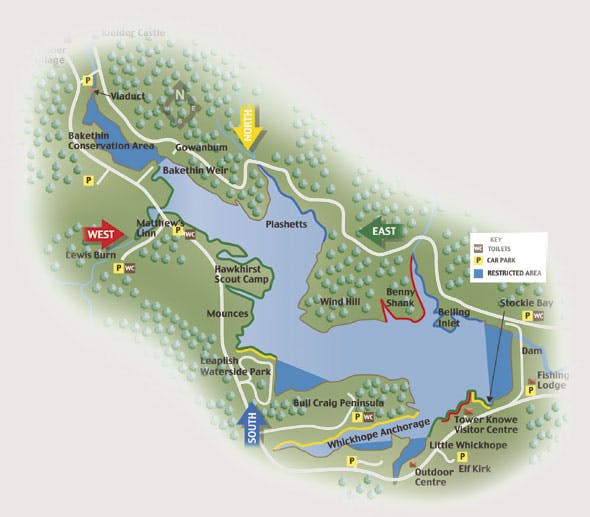
DIRECTION
BEST AREAS
Whickhope Anchorage, Stockie Bay. Leaplish
E
Little Whickhope, Mounces, Bakethin Weir, Matthews Linn
S
Plashetts, Belling Inlet
W
Benny Shank, Tower Knowe
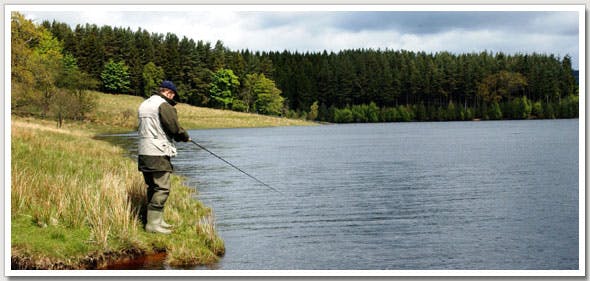
1 MOUNCES
This stretch runs from Leaplish to the scouting area, and offers an ideal natural bank. As it is not subject to a lot of angling pressure, the fish can often be found close in, ruling out the need for distance casting. Stocking takes place at either end of this stretch, so it often holds a lot of fish.
Best method: Floating or intermediate lines are favoured, with small black traditional patterns.
Best times: All season, though especially the warmer months.
Wading: Not usually necessary.
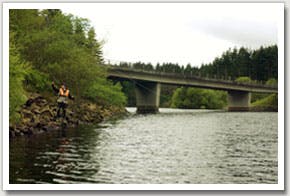
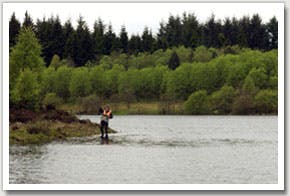
2 MATTHEWS LINN
One of the more popular areas, as it has become a renowned fish holding area. As it is one of the stocking points, it can get busy. Concentrate your efforts on the bridge and island area, as deep drops offs are found close in. However avoid this area after a period of heavy rain, as the Lewis Burn tends to flood pushing discoloured water into the reservoir.
Best method: Intermediate to a DI 3 line teamed with mini lures or traditional flies
Best times: April, May, June and July.
Wading: Yes, but beware of the drop offs.
3 BAKETHIN WEIR
One of the many secluded bays on Kielder which warms up much more quickly than the rest of the reservoir, due to the shallow water. Angling pressure does tend to push the fish out here, so long casting can be necessary. This is one of the best areas for the many thousands of wild browns. They will readily take small dark traditionals, such as Black Spider, Black Gnat, and Black and Peacock Spider, small Hoppers, Bibio, CDC, fished on top or up to a few feet down, though just sub surface is often effective.
Best method: Floating lines are usually all that are necessary.
Best times: Summer months.
Wading: With care.
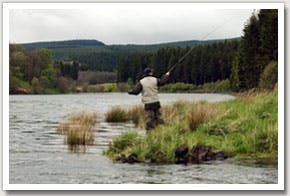
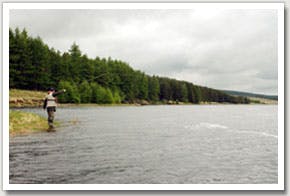
4 PLASHETTS
On the north shore, and not accessible by car, as the area is for forestry commission vehicles only. So to reach this stretch, hire a boat from Leaplish Waterside Park. There seems to be more natural feeding for the fish here than in most areas, as it is fairly shallow in places. The feeding means that some of the larger fish seek out this are – in fact no matter where they are stocked they find their way here. The area has shallows, drop offs and natural banks, so there are fish holding areas all along this bank.
Best methods: Intermediate lines with dark mini lures teamed with traditional patterns.
Best times: All season.
Wading: Not necessary.
5 BENNY SHANK
This is the long bank between Plashetts Quarry and the Belling inlet. For access use either the Osprey Ferry, or hire a fishing boat. This is a wind affected area, and if it is blowing from the west, fish tend to get pushed down towards the Belling Inlet. However, when the wind is not troublesome, browns can be free rising feet from the bank.
Best methods: Floating lines with wets or dries, or intermediate lines with small dark lures.
Best times: Mid to late season.
Wading: Not necessary.
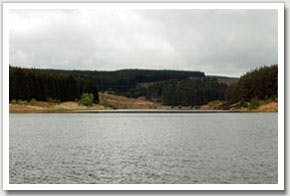
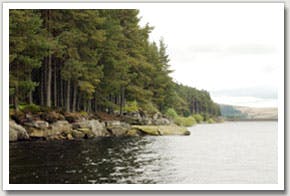
6 BELLING INLET
This long inlet is virtually a reservoir in its own right. Accessible by parking at the north abutment car park, which is two miles from the Belling, or by the ferry (times displayed on site). The area holds fish – stockies, established fish and brownies – throughout the season. Casting from the bank can be awkward if water levels are high, because of the proximity of trees and bushes. The best spot is at the bottom of the inlet.
Best methods: Intermediates or Wet Cel 2 with mini-lures.
Best times: All season, though especially early season.
Wading: Not necessary.
7 NORTH ABUTMENT
With easy access from the car park, this is the most popular bank on Kielder. The area is one of several stocking points, and fish can be found here throughout the season. At times long casting is required due to bank and boat pressure, though there is deep water close in.
Best methods: Intermediates down to DI-7 with bright mini lures.
Best times: All season.
Wading: Yes, but with care
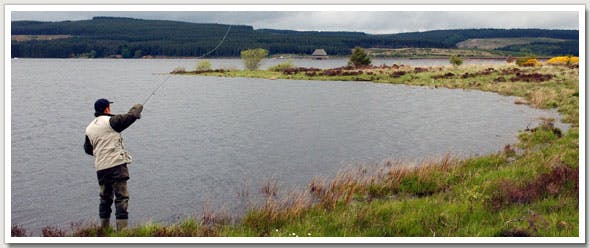
8 STOCKIE BAY
This is one of the reservoir’s most productive areas, and as the name suggests, the bay holds fish all season. Early in the season when water levels are high, sport can be fantastic, but as the levels drop, fish tend to move further out and distance casting can be needed.
Best methods: Intermediates with lures and traditionals.
Best times: All season, but especially early on.
Wading: Not necessary when water levels are high.
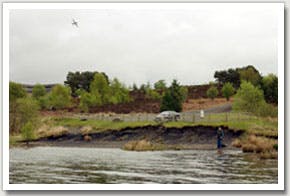
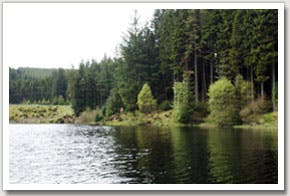
9 TOWER KNOWE
Stock fish tend to hold in this area, so boat and bank anglers consider this a hot spot. The depths vary considerable along the bank, so wading is not advisable. The stretch is easily accessible, and with amenities close at hand.
Best methods: Intermediate or Wet Cel 2 with bright mini-lures.
Best times: Early and late season.
Wading: No.
10 LITTLE WHICKHOPE
A good area for bank anglers, as it is a water ski-ing area so angling boats are not allowed. In recent seasons overwintered fish have turned up here in increasing numbers, and if the wind is from the east it will push Tower Knowe stockies into the area. Distance casting is not required.
Best methods: Intermediate with small dark traditional patterns.
Best times: Early to mid-season.
Wading: Not necessary.
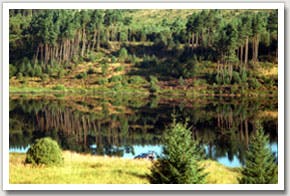
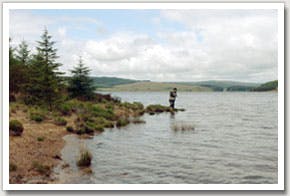
11 WHICKHOPE ANCHORAGE
Whickhope is a longrrow inlet, offering sheltered fishing among evergreen trees. If the wind is blowing into Whickhope it sometimes seems to hold all the fish in the reservoir – though the reverse is true and if the wind is blowing the other way, it can be devoid of fish.
Best methods: Intermediate lines with dark wets and mini-lures.
Best times: All season if the wind is favourable.
Wading: Not necessary. Cast and walk along the bank is a better bet.
12 BULL CRAG PENINSULA
This is one of the few spots on the reservoir where the old C200 road is visible, a remnant of the valley scene before it was flooded. Fish tend to run along this bank, so there always a chance of finding one or two here.
Best methods: Short casting with floating or intermediate lines with mini lures and winged wets or spider patterns.
Best times: All season.
Wading: Not necessary.
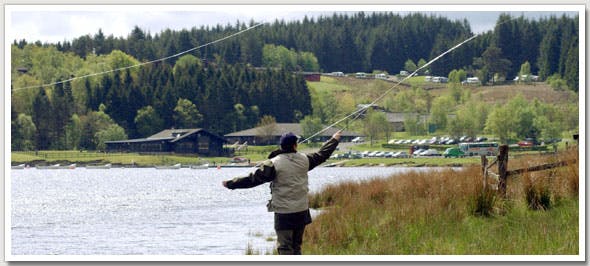
13 LEAPLISH WATERSIDE PARK
Leaplish holds stock fish all season. There is plenty of parking available here at one of the busiest spots on the reservoir. This is a consistent area with fish holding areas right along the bank.
Best method: Floating line with long leader, or an intermediate teamed with mini lures and wets.
Best time: All season.
Wading: Not necessary.





